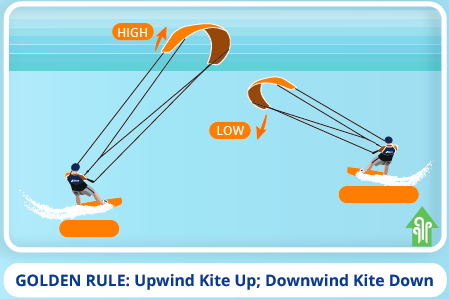When going into the water we want to make sure that no accidents happen, It's important to make sure you are safe and not harming others while enjoying your session. Similar to driving on the road, there are a few "traffic" rules that must be followed, to ensure we can ride safely in the vicinity of others.
These rules are meant to help you learn how to behave in a safe manner; especially during interactions with other Swimmers, Surfers, Kitesurfers, Windsurfers, Wingsurfers, Sailors, Boaters, Fishermen and all other possible water users.
We'll go over the general right of way rules for Kitesurfing derived from IKO,
and we'll expand a bit more with applications to other sports as well as some local insight.

Rule #1: The rider entering the water from the beach ALWAYS has right of way over the incoming rider coming to shore.
- We can't enter the water if there is an obstruction, regardless of which activity we choose to do.
- Be considerate and keep the launching area safe by not riding right in front of the beach where others may want to enter the water. By doing that you could be blocking other people from entering the water and putting them in a dangerous situation.
- Always take extra care when riding along the shoreline, to avoid colliding
with swimmers.

Rule #2: When 2 riders are on a collision course. The Starboard rider (right hand side going forward) has priority over the oncoming rider. The Starboard rider should keep his course, speed and heading to allow the other rider to adjust his course to avoid him. - The only "Rule" that you need to keep in mind is:
Right hand forward = Right of way.
- This is a standard rule that applies for all sailing and water sports,
wind powered or motor powered and regardless of size.

Rule #3: When two riders are traveling in the same direction, the faster rider/vessel must give way to the slower rider in front. - Slower riders are likely a novice with less skills or are in a difficult situation. If you are coming up faster from behind them, then you must give the slower rider the right of way.
- This applies to all regardless of which water craft is being used.

Rule #4: A rider surfing a wave has priority over the one who is going in the opposite direction. - A rider riding a wave can only go in one direction, regardless of which board or vessel they are using. Since they must follow the direction of the
wave, they have less control of where they can go. Therefore, all other
water users around them must allow them the space needed to continue
traveling in that direction and avoid collisions.

Rule #5: Right of way must be given to other ocean and beach users. A Kiteboarder must keep clear and where possible travel downwind of them.
- Kiteboarders can maneuver faster than other wind powered crafts.
They also have a better view of the situation because they are not being
obstructed by a sail in front of them. Therefore, Kiteboarders have the
least priority and must give way to all other water users.
- Pay extra attention to fishermen using local bangka boats.
These boats are not easily maneuverable and often cross the lagoons with
speed as they seek shelter from the waves.

Rule #6: To jump, a kiteboarder must have a clear safety zone of 50m downwind and 30m upwind. - Applicable to all sports, check the surrounding area before doing any sudden move.
- If you are going to do a turn, maneuver or jump, then it is your responsibility to check that you have enough clear space for the entire movement and landing, so you are not endangering other water users.

Rule #7: Use Common Sense with delicate situations on land. In a situation when two kiteboarders are on land at the same time, with one kiter preparing to enter in the water and the other one ready to land his kite, both should make sure they keep distance from each other.
- The safest behavior is to avoid this situation entirely.
- If you're launching your kite and about to enter the water, make sure there is no one trying to land their kite at the moment you are about to launch yours.
- Similarly, if you your coming in to land your kite, don't force land your kite if you see that there's someone on the beach about to launch theirs. Our beaches are narrow and we want to avoid crowding.
- Keep the kite parking neat at all times! Ideally, riders should either be out on the water riding or have their kites neatly parked with lines rolled up and boards to the side in order to keep the beach clear for all other users.

Kiteboarding's Golden Rule:
If you are passing upwind, keep your kite HIGH.
If you are passing downwind, keep your kite LOW.
- When crossing with another water craft, Kitesurfers have to make sure they keep their lines away from masts or heads of other people.
- It is always better to keep your kite higher for extra safety.

General Sailing Rule : The more upwind rider must give way to downwind rider. The more downwind rider can not see the upwind rider behind him. Therefore, the upwind rider must adjust his course so that he does not run into the downwind rider who is unable to see him coming.
Closing note : Most of our spots are HUGE, but our beaches are small.
If you give each other ample space and time, then you will hardly need to think about who has priority.

Comments